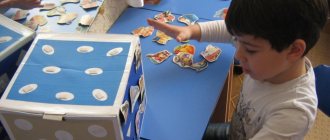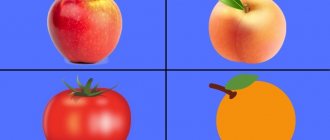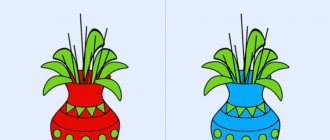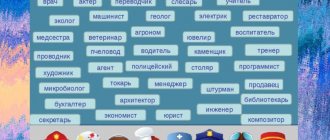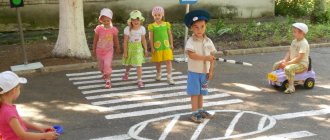Game activities on ecology in kindergarten. Junior group
Playful activity on ecology for children of primary preschool age “FAIRY FOREST”
Author: Alevtina Germanovna Korobkina, teacher of the preschool educational institution Kindergarten “Smile”, Perm region, urban-type settlement Suksun. Description: These games can be used by educators, counselors and primary school teachers, as well as parents. Goal: To create in children a joyful mood, positive emotions, through environmental games Objectives: Educational
To promote: consolidation of children's knowledge about wild animals and wild berries, the fly agaric mushroom.
strengthening the ability to draw flowers with crayons on the asphalt Developmental
To promote: the development of attention, memory, imagination, imagination, the development of interest in outdoor games
Educational
To promote: the development of a friendly attitude towards adults and peers
Organization of a kindergarten on the site. A character in a “Forest Fairy” costume, who is also the presenter, comes to the children. “Fairy of the Forest” Presenter: Hello, the kids call me “Fairy of the Forest,” and what’s your name, let’s get to know each other, and the butterfly will help us. Whoever the butterfly flies to says his name. Children say their names. Presenter: Well, we’ve met, now we can play. Children's answers Presenter: My butterfly really loves berries, do you like them? Children's answers Presenter: then let's play the game “NAME THE BERRY”, whoever the butterfly flies to names the berry.
Presenter: Well done, you know a lot of berries. You can go into the forest then. Shall we go through the raspberries into the forest? Children: yes Round dance game “Let’s go through the raspberries into the forest”
1. We’ll go through the raspberries into the forest, we’ll go into the forest, we’ll go into the forest (children walk in a circle). Let’s start a dance, let’s start, let’s start (one by one, put out your legs) The sun is in the yard, (hands are raised up, fingers are open “sun”) And in the forest there is a path (palms folded together perform wave-like movements in front of you) My sweet you, raspberry berry (sliding movements palms - “Skeet” movement) 2. You, raspberry, not in the mouth, not in the mouth, not in the mouth (pinch grip of three fingers of the leading hand, move towards the mouth) Pour into the box, box, box. (a pinch grip of three fingers of the leading hand imitates picking berries in a basket, in front of the chest
3. Like picking raspberries, picking, picking. (a pinch grip of the three fingers of the leading hand imitates picking berries from the ground - with the body tilted) We will bake pies, bake, bake (the “pies” movement)... 4. We will bake pies, bake, bake. (movement "pies").
Let’s call all our friends, let’s call, let’s call (movement of the hands, palms facing the face “invitation”). Presenter: Who else loves raspberries in the forest? Children: bear. Presenter: The bear has berries and mushrooms in the forest. Let's go collect, take the baskets.
Game “At the Bear in the Forest” I pick mushrooms and berries from the bear in the forest. But the bear is not sleeping, He keeps looking at us, And then he growls and runs after us! Presenter: we ran away from the bear. Did you find a lot of mushrooms? Children's answers Presenter : is there such a mushroom (shows a fly agaric), what is it called?
Children: fly agaric Presenter: can people collect it? Children: no Presenter: And what animals still live in the forest, riddles : 1. In the middle of a dense forest, a clubfooted and powerful one wanders. Loves fish, honey and raspberries, Sleeps in a den during the long winter.
Children: bear 2. His home is a hole under the tree. There are needles sticking out on the back. When he sees an enemy, he becomes like a thorny lump: neither eyes nor legs can be seen. Who is this?
Children: hedgehog 3. He is tall, horned, he is strong. He eats bark and branches in winter,
Children: elk 4. Red little animal jumps from a branch! Jump on the branch! Here's a nut, and here's a fungus - storing it for future use! What's his name?
Children: squirrel 5. Both cunning and careful. The tail is fluffy. Ginger colour. Loves chicken, mouse, and catching a bunny. Can you guess her name?
Children: fox 6. A gray and toothy predator prowls through dense forests.
Children: wolf 7. Long-eared, short-tailed, oblique eye, not easy to catch. Who's jumping across the field? Did you guess it?
Children: bunny Presenter: let's play with the bunny Game “The gray bunny is sitting” The gray bunny is sitting and moving his ears, Like this, like this, and moving his ears! (Children squat down and use their hands to imitate how the bunny moves its ears) It’s cold for the bunny to sit, we need to warm our paws, Like this, like this, we need to warm our little paws! (Children clap their palms together.) It’s cold for the bunny to stand, the bunny needs to jump! Skok - skok - skok - skok, the bunny needs to jump! (Children jump on two legs, pressing their hands to their chests) Someone scared the bunny, the bunny jumped and ran away. Presenter: the bunny ran away, but left us some crayons so that we could draw the flowers “Chamomile Field”
Children take crayons and draw flowers on the asphalt
The presenter - FOREST FAIRY gives butterflies to children and says goodbye to the children
We recommend watching:
Didactic game on ecology for preschoolers 5-6 years old. Environmental project in kindergarten in an early age group. Didactic games on ecology for preschoolers. Middle - senior group Ecological game for children of the preparatory group. Abstract
Similar articles:
What are educational games for preschoolers
Games to develop attention for children 3-4 years old in kindergarten in a group
Didactic games in the younger group. Card index
Playing with sand in the younger group
Equipment: Place identical sets of vegetables and fruits on two trays. Cover one for the teacher with a napkin. Progress of the game: The teacher briefly shows one of the objects hidden under the napkin, removes it again, then asks the child: “Find the same one on another tray and remember what it’s called.” The task is completed until all the fruits and vegetables under the napkin are named. “Guess what’s in your hand” Didactic task: Recognize the named object using one of the analyzers. Game action: Running to the teacher with an object recognized by touch. Rule: You cannot look at what is in your hand. You need to find out by touch. Progress of the game: The child puts his hands behind his back. Then the teacher moves away and shows a vegetable or fruit. If the child has the same one in his hands behind his back, the child should run up to the teacher. “Tops - roots” Didactic task: To consolidate knowledge about the gifts of the garden and vegetable garden. How to play: Children sit in a circle. The teacher names vegetables, the children make movements with their hands: if a vegetable grows on the ground, in a garden bed, the children raise their hands up. If the vegetable grows underground, the hands are lowered down. “Wonderful bag” Didactic task: Find out an object using one of the analyzers. Game action: Search by touch for a hidden object. Rules: You cannot look into the bag. First you need to determine what is in your hand, and then show it. Equipment: For the first games, we select vegetables and fruits that differ sharply in shape, then more similar ones. A small opaque bag. Progress of the game: The teacher puts vegetables and fruits in a bag and asks to observe what he will do. Then he invites the child: “Find by touch, without looking into the bag, what you want.” Now tell me what you took.” Or you can ask: “find what I say.” Second option. Didactic task: Recognize an object by touch using the listed characteristics. Progress of the game: The teacher lists the signs that can be perceived by touch: shape, its details, surface, plane - and asks: “Find in the bag something that looks like a ball, but with a long tail, hard, not smooth.” According to the description, the child searches for and finds beets. First, vegetables and fruits, which differ sharply in shape, are placed into the bag. When repeating the game, you can select objects that are similar in shape, but differ in other ways. “Guess what you ate” Didactic task: Find out an object using one of the analyzers, stimulate the development of imagination. Game action: Guessing the taste of vegetables and fruits. Rules: You can't look at what you put in your mouth. You have to chew with your eyes closed, and then say what it is. Equipment: Select vegetables and fruits of different tastes. Wash them, peel them, then cut them into small pieces. Place the same items on the table for control and comparison. Progress of the game: Treat the child to one of the pieces, after asking him to close his eyes. “Chew well, now tell me you ate it.” Find the same object on the table.” “Find what I’ll tell you about” Didactic task: Find an object based on the listed characteristics. Progress of the game: The teacher describes in detail one of the objects lying on the table, that is, names the shape of vegetables and fruits, their color, taste. Then the teacher asks one of the children: “Show it on the table, and then name what I told you about.” Second option. Didactic task: Describe and name the characteristics of a plant in response to the teacher’s questions. Progress of the game: The teacher sits facing the children, with his back to the indoor plants standing on the table. The teacher asks one child to choose and show the children a plant, which he will then have to recognize from the children’s description. The teacher asks them questions about the presence of the stem, shape and color. For example: “What does it look like, a tree or grass? Is the trunk thick and straight? Are the leaves big, like a cucumber? Dark green, shiny? Having recognized the plant, the teacher names and shows it. “Find what I’ll tell you about 2” Didactic task: Training in quickly finding the named tree. Progress of the game: The game is organized as an outdoor game. The teacher explains that the driver can catch those children who are not standing near the named tree. The teacher first names those trees that have bright distinctive features, then those that are similar in appearance. All children must listen carefully to which tree is named and, in accordance with this, run across at the signal “One, two, three - run!” “Describe, we will guess” Didactic task: Identify and name the characteristic features of an object in response to questions from an adult. Progress of the game: The teacher tells the children: “From the vegetables that are on the table, choose one. I will ask what he is like, and you answer. Just don't say its name. I’ll try to guess from your answers.” Then the teacher begins to ask questions in a certain sequence: “What form? Everywhere, like a ball? Are there any holes? What colour?". Children answer questions in detail. After the children talk about the characteristic features of the object, the teacher guesses riddles. “What’s missing?” Didactic task: Name plants from memory. Progress of the game: The teacher asks the children to take a good look at how the plants stand and close their eyes. At this time, he swaps the plants on one table. And then he asks the children to rearrange the pots the way they were before, comparing their arrangement with the order of the plants on another table. “Let's treat the dolls” Didactic task: Continue to introduce auxiliary means that have a fixed purpose. Equipment: Two dolls, children's furniture and dishes. “Wonderful bag”, items to choose from (toys and natural objects). How to play: Place 3-4 small items in a bag. The teacher comes with a doll and asks the children to help the doll prepare a treat for the animals, they will also come to visit. One child, at the doll’s request, takes a carrot out of the bag for the bunny, another – an apple for the hedgehog, and a third – a nut for the squirrel. Each time there should be 3-4 items in the bag, so that, in addition to the necessary ones, there are additional ones (for example, a small ball, a plastic ring, etc.). Children who have taken out objects hold them in their hands. The teacher brings toys for the animals. Children take turns treating them, choosing who to give a carrot, nut, or apple. The animals are happy and thank the children. “Where did Sasha hide?” Didactic task: Grouping plants according to their structure (trees, shrubs). Progress of the game: The game is played during excursions to the forest or park. The teacher tells the children: “Now let’s play. You will be squirrels and bunnies, and one of you will be a fox. The squirrels are looking for a plant to hide on.” During the game, the teacher helps the children clarify that hares live and hide in the bushes. They choose a fox driver, give him a hat, a fox mask, and all the other children get hats of hares and squirrels. On the signal: “Danger fox!” squirrels run to the tree, hares run to the bushes. “In the winter dining room” Didactic task: To consolidate children’s knowledge about wintering birds and their names. Develop the ability to imitate their habits. Progress of the game: We look at pictures with birds, the teacher offers to name it and show how it screams, how it flies and jumps. “What kind of bird is this” Didactic task: To consolidate children’s knowledge of what sounds birds make, to teach them to easily pronounce the sound “R”. Progress of the game: The teacher, imitating the cry of a bird, asks the children who screams like that. Children, guessing, choose the corresponding picture. “Birds” Didactic task: To train children in the ability to coordinate their words and actions, to activate children’s speech. Progress of the game: The teacher reads a poem and the children show these movements. Two small birds were flying. As they flew, all the people watched. As they sat down, all the people were amazed. "What is it for?" Didactic task: Note their appearance, specify the names of body parts; tell us about where they live. Progress of the game: The teacher has pictures with images of animals, and the children have pictures of the habitats of various animals (burrow, den, river, hollow, nest, etc.). The teacher shows a picture of an animal. The child must determine where it lives, and if it matches his picture, “settle” it by showing the card to the teacher. “Which flower was removed?” Didactic task: Describe an object and recognize it by description. Progress of the game: Plants stand in their usual places. The teacher invites one of the children to choose one of them and describe it so that all the children know and can say what kind of plant it is. Consistency of description is necessary. Four or five plants are placed on a table. Children remember them. The teacher invites the children to close their eyes and removes one of the plants. Children open their eyes and remember which plant was still standing. The game is played 4-5 times. You can increase the number of plants on the table each time. “Guess by description” Didactic task: To develop in children the ability to take into account the named characteristics of an object and to develop observation skills. Progress of the game: There are five indoor plants on the table, which show clear signs of difference. After a verbal description of the plant, the child finds it among the others. “Guess whose tail” Didactic task: To develop the ability to analyze, consolidate the ability to distinguish and name animals. Progress of the game: The teacher gives the children drawn animal faces, and then one by one shows the drawn tails. Children must name “their” animal and choose a suitable tail for it. “Through the stream” Didactic task: To develop in children a sense of balance and attention. Progress of the game: Children are asked to carefully walk along the bridge (geometric fabric figures) to the other side and find themselves on the lawn, where they frolic and pick flowers. At the signal “Home!” returning across the bridge.
